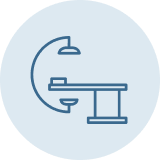What happens during rhinoplasty?
Before the rhinoplasty surgery, an IV line will be connected to your arm through which medications will be administered. You will be taken to the operation theater (OT) and the surgery procedure will take place in the following order-
- Intravenous sedation or general anesthesia is administered to put the patient to sleep.
- An incision is made inside or outside the nose, depending on which technique is followed - open or closed surgery.
- If the open technique is chosen, the incision is made across the columella. In the closed technique, the incision is made inside the nose where they can be hidden.
- The skin that covers the nasal bones and cartilage is raised gently to access the structure of the nose.
- Depending on the changes required or desired by the patient, the plastic surgeon will make the modifications in the bone, cartilage, and skin tissues.
- If required, a deviated septum is straightened and the projection of the nose is corrected to improve breathing.
- Once the necessary changes are done and the nose is sculpted, the skin and tissues are placed back and incisions are closed with the help of stitches.
- A gauze and splint will be placed to support the nose.
The entire procedure can take 1-2 hours approximately. Once the surgery is completed, the patient is discharged on the same day.
Reasons to Undergo Rhinoplasty
Most people who wish to undergo rhinoplasty are unsatisfied with their nasal and facial appearance, hence rhinoplasty is mostly considered as a cosmetic surgery.
The aesthetic reasons to get a rhinoplasty may include the following-
- The side of the nose covers a large part of your face.
- You are not happy with the width of the nose.
- There are visible depressions or bumps on the nose bridge.
- The nose tip is pointed upward or downward direction, not to your liking.
- You don’t like the shape or width of the nostrils.
- The nasal passage is not symmetrical.
The above are the purely cosmetic reasons for which people might choose rhinoplasty. However, the procedure can be chosen for medical reasons too. These reasons include-
- Nasal Abnormalities- The surgeon can treat deformities, polyps, rhinitis, and other abnormalities in the nose structure while performing rhinoplasty.
- Nasal Obstruction- If a person has a deviated septum that is obstructing the nasal passage, the doctor can combine rhinoplasty with septoplasty and reconstruct the nasal passage to improve breathing.
- Nasal Injuries- In case the person’s nose shape is distorted due to injury or some trauma, rhinoplasty can help to correct them.
- Failed Previous Rhinoplasty- A person who's had rhinoplasty in the past but the results were not satisfactory can also undergo rhinoplasty to get the desired results.
So, whether you want to change the shape, size, or proportions of the nose or need to correct deformities, or birth defects, or improve breathing problems, rhinoplasty is the best option.
How to prepare for rhinoplasty surgery?
There are no extensive preparations required before undergoing a rhinoplasty. The doctor will ask you to get specific diagnostic tests done. Some instructions will also be given by the surgeon before the surgery-
- Avoid taking aspirin, anti-inflammatory drugs, or herbal supplements as they can increase your risk of bleeding.
- Stop smoking entirely for at least a month before the surgery is planned.
- Start eating a healthy diet and increase your consumption of protein and other essential nutrients to improve your body’s healing abilities.
On the day of surgery, you will be asked to get admitted to the hospital at midnight. The medical team will instruct you to avoid eating or drinking anything 6-8 hours prior to the surgery. Also, ask a friend or family member to accompany you and take you home after the procedure.
What to expect after the surgery?
Right after the surgery, you will be kept under observation for a few hours. When you wake up, you’ll feel slightly disoriented and nauseous. Your vital signs will be monitored for a while and you will be able to go home on the same day. Only in case of complications, the doctor will ask you to stay overnight.
The internal dressing will be there for 1 to 7 days and the splint needs to be kept for at least one week. There will be slight bleeding and drainage of mucus for a few days. The nursing team will provide instructions to change the gauze dressing at home.
Before discharge, you will be given a recovery guide, diet chart, and follow-up timeline. Make sure that you visit the doctor for follow-ups so that he/she can monitor your recovery.
Risks & Complications Associated with Rhinoplasty
The major risks of rhinoplasty are bleeding, infection, and adverse reactions to the anesthesia. Other than that, there are rare of chances of the following risks arising-
- Difficulty in breathing through the nose
- Temporary or permanent numbness in and around the nose
- Possibility of unevenness or asymmetrical results
- Pain, discoloration of skin, or swelling that doesn’t go away
- Septal perforation (a hole in the septum)
- Need for revision surgery
Usually, these risks can be mitigated by an experienced and skilled plastic surgeon.
Recovery
The recovery after surgery will take around one month depending on the patient’s healing abilities. Throughout the recovery period, you’ll have to take care of the following things-
- Avoid strenuous activities, including aerobics, jogging, and lifting heavy objects as it can put strain on the nose.
- Take baths instead of showers as long as the bandages are being used.
- Do not blow your nose and avoid a dusty environment that can make you sneeze.
- Eat a high-fiber diet consisting of fresh fruits and vegetables to avoid constipation.
- For a month, try to avoid extreme facial expressions, including smiling and laughing.
- While brushing your teeth, make sure that you gently move the upper lip and be smooth.
- Wear loose clothes that do not rub against your nose when you wear or remove them.
- Avoid using eyeglasses or sunglasses for 4 weeks after the surgery to avoid putting pressure on the nose.
- Wear SPF 30, 40, or 50 when you go outside to ensure that sunlight doesn’t cause discoloration of the skin.
By following these tips, you will be able to recover and get back to your normal routine as soon as possible.
Results of Nose Surgery
Right after the surgery, you will notice changes in your nose shape and structure. The results of rhinoplasty take around 6, 9, or 12 months to finalize. Throughout this period, you will have to make sure that you don’t get injured or care well for your nose.
If you are not satisfied with the results, you can wait for the nose to heal and undergo a second rhinoplasty surgery for further modifications.





